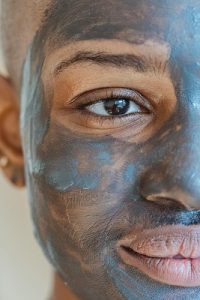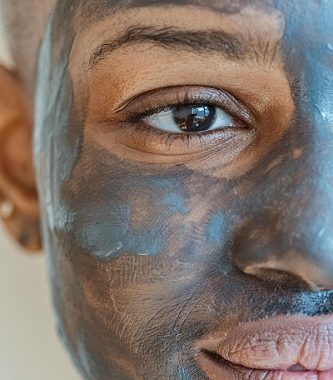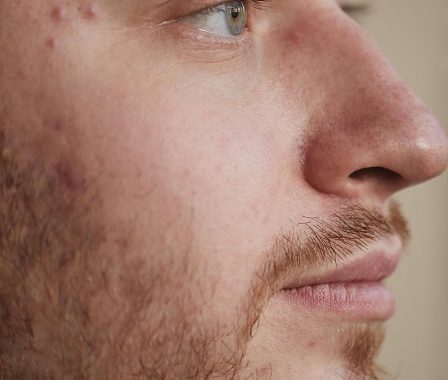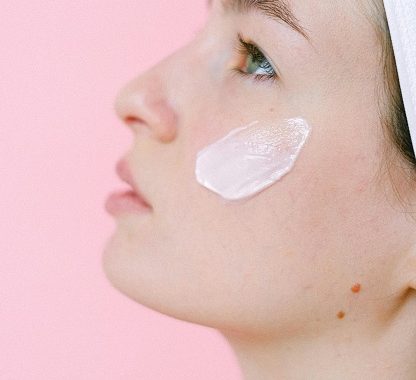
Dealing with acne can be frustrating, especially when it seems like nothing you do can clear it up fast enough. Hormonal acne, in particular, can be stubborn and persistent, often requiring specific strategies for effective treatment.
In this article, we’ll explore how to tackle hormonal acne swiftly and efficiently, addressing common questions and concerns along the way.
Understanding Hormonal Acne:
Before diving into treatment methods, it’s crucial to understand what hormonal acne is and what distinguishes it from other types of acne. Hormonal acne typically manifests as deep, cystic lesions along the jawline, chin, and sometimes the neck and back.
It’s caused by fluctuations in hormone levels, particularly androgens such as testosterone, which stimulate the production of excess oil in the skin’s sebaceous glands.
This excess oil, along with dead skin cells, can clog pores and lead to inflammation, resulting in painful and often stubborn acne breakouts.
How to Tell if Acne is Hormonal or Bacterial:
Differentiating hormonal acne from bacterial acne is essential for targeted treatment. Hormonal acne typically manifests as deep, cystic lesions clustering around the jawline and chin.
Conversely, bacterial acne presents as inflamed pustules or papules dispersed across the face. Moreover, hormonal acne’s severity often correlates with hormonal fluctuations, notably during menstruation, puberty, or pregnancy.
Observing these patterns alongside the location and appearance of breakouts can aid in accurate diagnosis. This knowledge empowers individuals to tailor their skincare regimen and seek appropriate medical interventions.
Consulting a dermatologist ensures precise identification and guides personalized treatment strategies, optimizing outcomes for managing acne effectively.
Best acne scar removal products
Identifying Hormonal Acne:
Identifying hormonal acne requires a keen understanding of its distinctive characteristics. Hormonal acne typically manifests as deep, inflamed lesions concentrated along the jawline, chin, and occasionally the neck and back.
These breakouts often present as cysts or nodules rather than surface-level pimples and may be tender or painful to the touch.
Unlike bacterial acne, which tends to produce inflamed pustules or papules scattered across the face, hormonal acne forms larger, more concentrated clusters.
To aid in the identification process, examining hormonal acne pictures can be invaluable. These images serve as visual references, offering insight into the specific appearance and distribution of hormonal acne lesions.
By comparing these images to their own skin, individuals can better recognize the telltale signs of hormonal acne, such as its characteristic location along the jawline and chin.
Additionally, observing the size, depth, and inflammation level of the acne lesions depicted in these pictures can provide further clarity in distinguishing hormonal acne from other types.
Furthermore, understanding the context in which hormonal acne tends to arise can also aid in its identification.
Hormonal fluctuations related to puberty, menstruation, pregnancy, menopause, or conditions like polycystic ovary syndrome (PCOS) can all contribute to the development of hormonal acne.
By recognizing these hormonal triggers and their potential impact on the skin, individuals can better assess whether their acne may be hormonally influenced.
In summary, identifying hormonal acne involves recognizing its unique presentation, including its location, appearance, and associated hormonal triggers.
By utilizing hormonal acne pictures as a reference point and considering individual hormonal profiles, individuals can more accurately diagnose and address this specific type of acne.
Best acne scar removal products
Addressing the Root Causes:
Addressing the root causes of hormonal acne requires a multifaceted approach aimed at restoring hormonal balance and promoting skin health.
Lifestyle modifications play a pivotal role, encompassing dietary adjustments, stress management techniques, regular exercise, and adequate sleep.
A balanced diet rich in antioxidants, essential fatty acids, and low-glycemic index foods can help regulate hormone levels and reduce inflammation, contributing to clearer skin.
Stress management techniques such as mindfulness meditation, yoga, or deep breathing exercises can mitigate the impact of stress hormones on acne flare-ups.
Furthermore, regular physical activity not only promotes overall well-being but also helps regulate hormone levels and improve circulation, which can enhance skin health.
In addition to lifestyle modifications, establishing a tailored skincare routine is crucial for managing hormonal acne.
This includes gentle cleansing to remove excess oil and impurities without stripping the skin, followed by the use of non-comedogenic moisturizers and sunscreen to maintain hydration and protect against UV damage.
Incorporating topical treatments containing ingredients such as salicylic acid, benzoyl peroxide, or retinoids can help unclog pores, reduce inflammation, and promote cell turnover, aiding in the prevention and treatment of hormonal acne breakouts.
In cases where lifestyle modifications and skincare routines alone are insufficient, medical interventions may be necessary.
This may involve prescription medications such as oral contraceptives, spironolactone, or oral antibiotics to regulate hormone levels, reduce oil production, or combat bacterial overgrowth.
Consulting with a dermatologist or healthcare provider can help determine the most appropriate treatment approach based on individual needs and circumstances.
By addressing the root causes of hormonal acne through a comprehensive approach, individuals can achieve long-term management and maintain clear, healthy skin.
Best acne scar removal products
Hormonal Acne Diet:
Diet plays a significant role in managing hormonal acne, as certain foods can exacerbate hormonal imbalances and trigger acne flare-ups.
Dairy products, for example, contain hormones and growth factors that may stimulate oil production in the skin, leading to clogged pores and breakouts.
Similarly, high-glycemic index carbohydrates, such as white bread, sugary snacks, and processed foods, can cause spikes in blood sugar levels, triggering the release of insulin and other hormones that contribute to acne formation.
To combat hormonal acne through diet, it’s essential to focus on incorporating nutrient-dense foods that support hormone regulation and promote clear skin.
Opting for a balanced diet rich in fruits, vegetables, lean proteins, and whole grains provides essential vitamins, minerals, and antioxidants that help regulate hormone levels and reduce inflammation.
Fruits and vegetables are particularly beneficial due to their high fiber content, which aids in digestion and helps eliminate excess hormones from the body.
In addition to emphasizing whole foods, it’s also essential to pay attention to hydration.
Drinking plenty of water helps flush toxins from the body and keeps the skin hydrated, reducing the likelihood of clogged pores and acne breakouts.
Overall, adopting a diet focused on whole, nutrient-dense foods can play a crucial role in managing hormonal acne by supporting hormone balance and promoting clear, healthy skin.
By making conscious choices about what you eat, you can take proactive steps towards reducing acne flare-ups and achieving long-term skin health.
Best acne scar removal products
Best Hormonal Acne Treatment:
When it comes to treating hormonal acne, there are several options to consider:
- Topical Treatments: Over-the-counter and prescription topical treatments containing ingredients like benzoyl peroxide, salicylic acid, or retinoids can help unclog pores and reduce inflammation.
- Oral Medications: In severe cases, oral medications such as oral contraceptives, spironolactone, or oral antibiotics may be prescribed to regulate hormone levels or combat bacterial overgrowth.
- Natural Remedies: Some individuals find relief from hormonal acne through natural remedies such as tea tree oil, green tea extract, or evening primrose oil. While research on the effectiveness of these remedies is limited, they may offer some benefits for certain individuals.
- Lifestyle Changes: Stress management techniques, regular exercise, adequate sleep, and avoiding triggers such as harsh skincare products or excessive sun exposure can also help manage hormonal acne.
Which Hormone Causes Acne in Females?
In females, hormonal acne primarily stems from the influence of androgens, particularly testosterone.
Androgens are male hormones present in both males and females, albeit in different levels. When there’s an increase in androgen levels in females, it triggers the sebaceous glands to overproduce oil, or sebum.
This excess sebum combines with dead skin cells, creating a breeding ground for acne-causing bacteria, ultimately resulting in breakouts.
Moreover, hormonal fluctuations inherent to the female reproductive system can exacerbate acne.
During the menstrual cycle, for instance, hormonal shifts occur, leading to an increase in androgen production, which can exacerbate acne symptoms, especially around menstruation.
Pregnancy and menopause are also periods marked by significant hormonal changes that can impact sebum production and skin health, potentially leading to acne flare-ups.
Furthermore, conditions like polycystic ovary syndrome (PCOS) can significantly disrupt hormonal balance in females. PCOS is characterized by elevated androgen levels, insulin resistance, and irregular menstrual cycles.
These hormonal imbalances can manifest as acne, often presenting as cystic lesions along the jawline and chin.
In summary, hormonal acne in females is primarily driven by fluctuations in androgen levels, exacerbated by hormonal changes related to the menstrual cycle, pregnancy, menopause, and conditions such as PCOS.
Understanding these hormonal dynamics is crucial for effective management and treatment of hormonal acne in women.
Best acne scar removal products
Conclusion:
While hormonal acne can be challenging to manage, it’s not impossible to clear up fast with the right approach.
By understanding the underlying causes, identifying triggers, and adopting a comprehensive treatment plan that addresses both internal and external factors, individuals can effectively combat hormonal acne and achieve clearer, healthier skin.
Remember to consult with a dermatologist or healthcare provider for personalized advice and treatment recommendations tailored to your specific needs and concerns. With patience and persistence, you can take control of your hormonal acne and regain confidence in your skin.
Further Reading:
How to Prevent and Treat Hormonal Acne, According to Dermatologists
Got Adult Acne? Get Answers from an Expert
FAQs:
How long does it take for hormonal acne to clear up?
The duration for hormonal acne to clear up varies greatly depending on individual factors such as severity, treatment efficacy, and adherence to skincare routines. In some cases, hormonal acne may resolve within a few weeks with proper treatment, while for others, it may take several months to see significant improvement. Consistent skincare habits, lifestyle changes, and targeted treatments can expedite the clearing process, but patience is often necessary as hormonal imbalances can be complex and may require time to rebalance. Consulting with a dermatologist can provide personalized guidance and treatment options to expedite the clearance of hormonal acne.
�
How do you get rid of hormonal acne overnight?
Getting rid of hormonal acne overnight is challenging, but some steps may help: Firstly, cleanse your face gently with a mild cleanser. Then, apply a spot treatment containing benzoyl peroxide or salicylic acid to target active breakouts. Moisturize with a non-comedogenic product to keep the skin hydrated. Avoid touching or picking at acne lesions to prevent further irritation. Additionally, consider using a clay mask to absorb excess oil and reduce inflammation. Lastly, ensure you’re getting enough sleep and managing stress levels, as lack of sleep and stress can exacerbate hormonal acne.
�
How I cured my hormonal acne?
I tackled my hormonal acne by addressing internal and external factors. Through dietary adjustments, I cut down on dairy and refined sugars, focusing on whole foods rich in vitamins and minerals. I incorporated topical treatments like salicylic acid and retinoids to unclog pores and reduce inflammation. Additionally, stress management techniques and regular exercise helped balance hormone levels. Consulting with a dermatologist for personalized advice was key in finding the right treatment plan. Over time, these efforts led to clearer, healthier skin and boosted my confidence.
�
What can I drink to clear hormonal acne?
To clear hormonal acne, consider drinking plenty of water to hydrate your skin and flush out toxins. Green tea is rich in antioxidants and can help reduce inflammation. Spearmint tea may lower androgen levels, potentially decreasing acne severity. Herbal teas like chamomile or peppermint can promote relaxation, which may help manage stress-induced acne. Avoid sugary drinks and excessive caffeine, as they can exacerbate hormonal imbalances and inflammation. Additionally, incorporating fresh fruit and vegetable juices can provide essential vitamins and nutrients for healthy skin.



